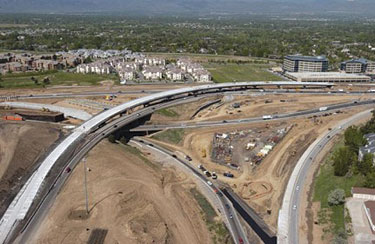I-25 & I-225 Reconstruction - Denver, CO
FAST FACTS ABOUT: 1-25 & I-225 Reconstruction
Types of TDM: Mode Choice, Route Choice
Keywords: design-build, corridor reconstruction, construction
mitigation, rideshare, transit subsidies
Area Demographics: Metropolitan Denver, T-REX includes
both light rail construction and highway capacity and safety improvements
to I-25 and I-225.
Program: TransOptions offers transit and vanpool subsidies,
community outreach and education on construction and transportation
options.
Results: Transit and vanpool subsidies account for
a daily VMT reduction of 74,800. Refer to the case study for additional
results.
Cost of Program: $3 million allocated to TransOptions.
Contact: Allison Hodge, Director of TransOptions, HodgeAM@trexproject.com

Area Characteristics
The I-25 corridor in metropolitan Denver is one of the most overburdened
sections of roadway in Colorado. Over the past twenty years the region
has experienced intense residential and employment growth leading to
increased travel demand and congestion along the I-25 corridor.
In an effort to confront congestion along I-25, the Colorado Department
of Transportation (CDOT) and the Regional Transportation District (RTD)
initiated a multi-modal design-build project known as the Transportation
Expansion Project, or T-REX. The design-build approach compliments T-REX
project goals, which are:
• Minimize inconvenience to the public,
• To stay within the $1.67 billion project budget,
• To provide a quality product, and
• Complete the project on time (2008).
The project is ahead of schedule and is estimated for completion in
2006.
The T-REX project includes both light rail construction and highway
capacity and safety improvements. T-REX, a design-build project, will
add many new elements to the transportation system including 19 miles
of double track light rail, 13 light rail stations (all but one with
park & Ride lots), 34 additional fleet vehicles, and a new maintenance
facility. The project will also provide additional lanes on both I-25
and I-225 within project limits as well as other safety improvements
associated with save ingress and egress.
Program Description
T-REX owners recognized the potential impact that the large-scale project
could have on the motoring public and took steps to minimize inconvenience
associated with the reconstruction project. The TransOptions program
was formulated in consultation with key community stakeholders as a
construction mitigation program designed to assist employers and commuters
in dealing with the challenges of traveling to, from and through the
corridor during construction. CDOT and RTD dedicated $3 million to the
TransOptions program, which included transit and vanpool subsidies,
community outreach and education as well as maintaining a project website.
The project is now in it’s fourth construction season (2004).
TransOptions has been recognized as a key element of construction mitigation
by providing commuters and employers with incentives to use alternative
modes to, from and through the corridor. TransOptions builds on the
success of the TMAs and TMOs and established demand-side programs implemented
by local jurisdictions including the Denver Regional Council of Government’s
(DRCOG) RideArrangers.
Facilitative leadership has helped avoid roles and responsibilities pitfalls. For continued success, it will be important to communicate the role of agency partners to ensure focused but collaborative efforts through established and new partnerships.
Due to the fluid nature of a design-build project and the foresight
of those involved, a number of recent project features have been deployed
to manage travel demand during construction. In November 2002, T-REX
opened a temporary bus/HOV lane on I-25 to promote the benefit of higher
occupancy modes. In May of 2003, T-REX launched a real-time instant
email alert system utilizing project ITS components as they became operational.
In May of 2003, TransOptions was honored with a TDM Award presented
by the Southeast Business Partnership for it’s continued commitment
to and success with construction related transportation management to
date.
Measures of Effectiveness
Recently, the T-REX TransOptions program has undergone an evaluation
of it’s first two years (2001 and 2002) utilizing a variety of
measures including documentation review, stakeholder interviews, e-mail
surveys, and quantitative analyses of program data. The evaluation identifies
strengths and weaknesses of the TransOptions program, as well as opportunities
and threats for the future of the program.
By reducing daily vehicle miles traveled (VMT) along the T-REX corridor,
the TransOptions program is contributing to T-REX’s goal of minimizing
inconvenience along the corridor. As part of recent analysis conducted
by UrbanTrans Consultants, Inc., TransOptions contributed to VMT reduction
was measured. Collectively, transit and vanpool subsidies provided by
TransOptions have reduced daily VMT by 74,800. The following successes
have been cited as contributors of VMT reduction based on analysis completed
to date:
• 14 employers purchased Eco Pass which resulted in over 1,200 employee Eco Pass holders,
• 66 commuters purchased ValuPass,
• 318 commuters purchased subsidized transit pass products at 4 Sales Pass Outlets established with T-REX support,
• 80 commuters utilized Commuter Checks to purchase transit products,
• 179 Vanpool riders received T-REX TransOptions subsidies, and
• 9 Vanpools were formed.
A number of TransOptions strengths were documented as part of the evaluation
and are seemingly applicable to all highway reconstruction projects.
Collaborative, responsive leadership of the TransOptions staff is imperative
for the continued interest of project team members including the TMA/TMOs,
DRCOG, RTD and the TransOptions TDM Committee. Facilitative leadership
has helped avoid roles and responsibilities pitfalls. For continued
success, it will be important to communicate the role of agency partners
to ensure focused but collaborative efforts through established and
new partnerships. Program credibility continues to be strengthened by
the presence of a public relations firm on the TransOptions team. Marketing
and public relations outreach of the TransOptions program resulted in
increased employer and employee awareness of transit, vanpool and carpool.
Success is evident measured by the implementation of over 300 events,
attended by more than 20,000 persons by the end of 2002. In addition,
just as important as providing employers and commuters with subsidized
transit and vanpool products, it was necessary to enable the TMA/TMOs
and DRCOG the tools to effectively provide those products. TransOptions
is flexible in nature, adjusting to user needs.